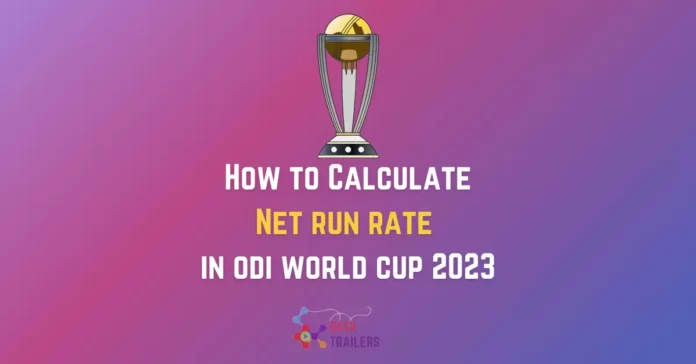Net run rate is the primary metric or element used to evaluate any team’s performance in cricket. NRR is vital in determining the final standings in the biggest tournaments of cricket, such as World Cup and Asia Cup.
It determines final table standings and provides an assessment of any team’s overall performance. It is used to calculate the skill of every player collectively rather than an individual player of the team.
Moreover, It is an important indicator that will definitely be used during the upcoming ODI World Cup in 2023.
It is mostly used when two teams have equal points in a 50 or 20-over game. The finalist team is decided on the basis of the net run rate greater than the opposition team.
Net Run Rate Formula in ODI Worldcup 2023
In order to calculate the net run rate for the ODI World Cup in 2023, we need four statistics.
- Total Runs Scored by a Team
- Total Overs Faced by a Team
- Total Runs Conceded by a Team
- Total Overs Bowled
So, the actual formula for calculating the net run rate is as follows.
Net Run Rate= (Total Runs Scored by a Team / Total Overs Faced by a Team) – (Total Runs Conceded by a Team / Total Overs Bowled)
Now, we will apply the above formula to Calculate the Net run rate of Team India in the 2011 ODI World Cup Final.
- Team India bowled first and conceded 274 runs from Sri Lanka in 50 overs.
- In reply, India chased the target in 48.2 overs.
- Calculate Sri Lanka’s run rate: 274/50 ≈ 5.74
- Now calculate India’s run rate 277/50 ≈ 5.54
- Subtract Sri Lanka’s run rate from the West Indies run rate to determine the final run rate value.
- India’s net run rate≈ of 5.74-5.54 is 0.2
Here are some scenarios that will affect how any team calculates the Net Run Rate.
When a team is bowled out, what happens?
If a side is bowled out, that is, they lose all ten wickets before their quota of overs has been reached, we must still consider them to have played more than their quota of overs.
Calculating Net Run Rate When One Team is Bowled Out
Suppose Team A scored 300-7 in 50 overs, and Team B was bowled out for 200 in 45. When calculating NRR, we need to keep in mind that Team B faced 50 overs rather than just 45.
Team A Net Run Rate is:
Team A = (300/50 – 200/50)
= (06-04)
=02
Team B Net Run Rate is:
Team B = (200/50-300/50)
= (4-6)
= -2
Therefore, team A net run rate is positive, and team B net run rate is negative. So, team A is ahead in terms of net run rate than team B.
NRR: When a match is called off?
According to ICC Men’s ODI Playing Conditions Rule 16.10.2:
“Only those matches where results are achieved will count for the purpose of net run rate calculations. Where a match is abandoned, but a result is achieved under Duckworth/Lewis, for net run rate purposes Team 1 will be accredited with Team 2’s Par Score on abandonment off the same number of overs faced by Team 2. Where a match is concluded but with Duckworth/Lewis having been applied at an earlier point in the match, Team 1 will be accredited with 1 run less than the final Target Score for Team 2 off the total number of overs allocated to Team 2 to reach the target.”
What happens to the net run rate if the outcome of the match is tied?
Even if a match between two teams is tied, each team’s performance is calculated and added to the overall performance to get an overall run rate.
How Do You Round Off-Net Run Rate?
Three decimal places are preferred when calculating the Net Run Rate. Positive and negative signs are used for the calculation of the net run rate.
Conclusion:
In conclusion, Net Run Rate (NRR) is far more than an actual statistic in cricket. It is a reflection of a team’s overall performance and a critical factor in tournament dynamic range.
It reflects the essence of a team’s batting and bowling tactics, allowing for a fair and objective analysis of a team’s strengths and weaknesses. It reminds us that, in cricket, every run counts, and every wicket taken can change the course of history.




